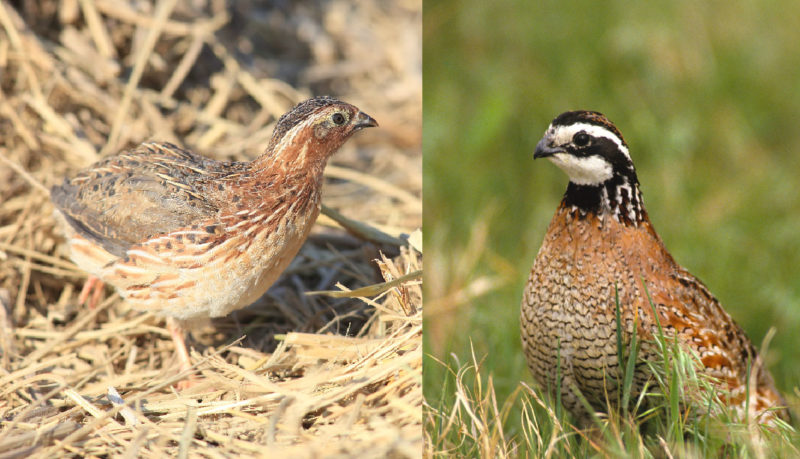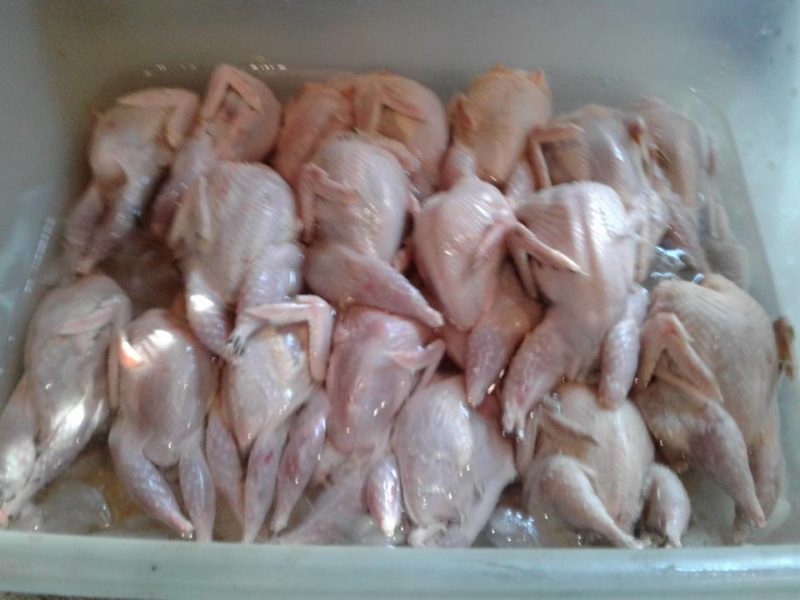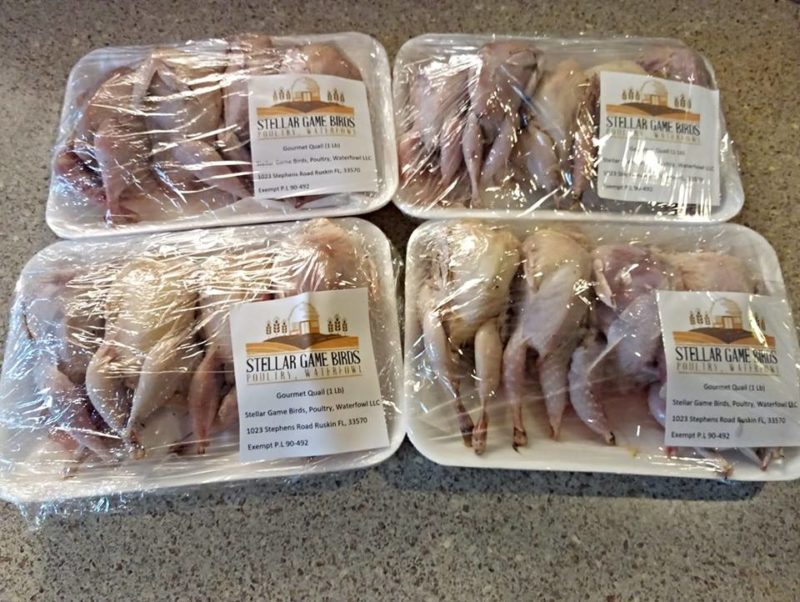Learn more about quail meat and how to process your birds for home use or market from quail expert Alexandra Douglas.
Quail have been (and are still) typically served in fancy restaurants as a delicacy. These days, folks like to know what’s in their food, and one of the best ways to do this is to raise your own meat. As homesteading and quail farming have become both more popular and economical, people are raising their own birds, and need to know how to process them.
Coturnix vs Bobwhite Meat
If you have limited space for raising meat birds, quail are a wonderful alternative to chickens, ducks, or geese. Many people still hunt wild quail such as bobwhites, but for those who want to grow their own, the domestic Japanese Coturnix quail are the perfect option.
Coturnix quail meat is low in LDL cholesterol and saturated fat; high in protein (compared to chicken); and contains niacin, and vitamins B and C. The meat is dark with a rich flavor similar to turkey meat.

Japanese Coturnix quail (left), Bobwhite quail (left). Getty Images.
Bobwhite quail are also a great source of high protein, vitamin-rich meat. Because their diet is different than domestic quail raised on prepared feed, Bobwhites have a gamier taste, which some people prefer.
Fast Maturity
Japanese Coturnix mature within six weeks, and most owners let them fatten out for another two weeks before processing. Because I practice selective breeding, I wait until at least 9 weeks, so I can see which birds have the best weight at that time. I keep those birds to breed them, and then process the rest between 9 and 12 weeks. After 12 weeks, the meat becomes tougher and those birds are best used in stews.
You can read more about selective quail breeding in Selectively Breeding Coturnix.
Homesteading and Self Sufficiency with Quail
Because domestic quail mature so quickly, they’re ideal homesteading birds; you can keep your family fed year-round with quail meat. The Japanese Coturnix are also a dual-purpose birds, as they lay large clutches of eggs which you can eat or hatch out.
Think about the math. Eggs typically hatch within 17 or 18 days. The chicks grow rapidly, reaching laying maturity within six weeks. You can begin to cull and process for meat between six to eight weeks. In other words, you can be processing as many birds as you have room for every eight to ten weeks from hatching to maturity. You can hatch them more often if you have two groups on different laying cycles. It’s a great production system.
Because we’ve developed a strain of Jumbo Coturnix, which dress out at two to three quail per pound, we can feed the family with fewer birds.
What Supplies do you need for Harvesting Quail?
Before you bring in quail to be processed, it’s good to be prepared and all set up. This makes things smoother and shortens the overall processing time. Most of the tools you’ll need are probably already in your kitchen.
Tools and Materials
– Kitchen shears
– Kitchen tongs
– Kitchen gloves
– Stove
– clean counter
– Sink
– ice chest or cooler
– 5 pounds ice cubes
– 5-gallon stock pot
– Bowl for intestines
– Thermometer
For Home Packaging and Storage
– Freezer bags
– Permanent marker
– Scale
-Check with your local and state regulations to see what materials you’ll need for commercial packing and storage.
First, I sanitize to area and tools for processing: stove, sink, counter, ice chest, large pot, thermometer, shears and tongs. Because I sell quail meat in Florida, I have to follow food process permit laws, which require that I have a 3-compartment stainless steel sink. If you’re interested in selling quail meat at a farmer’s market or to local restaurants, be sure to check your local and state regulations for process and packaging.
If you’re harvesting just for family and friends, you don’t need to use an industrial sink. But still be sure to sanitize all your tools carefully.
Dispatching
First, fill your pot with water and bring to a 160-degrees-Fahrenheit boil. If the water is too cool, it won’t loosen the feathers from the skin sufficiently. If the water is too hot, you’ll start to cook the meat.
I find that the fastest, most humane way to dispatch a quail is with kitchen shears. Hold the quail over a sink, holding the bird firmly. Take the kitchen shears and sever the head. You’ll see some movement; however, this isn’t the bird suffering. It’s just the nerves. Hold the bird firmly as the nerves will cause it to flap around and cause a mess if you’re not careful. Continue to hold the bird over the sink and let the blood drain for a minute. You can learn to do multiple birds at once.
Lots of people chose to harvest quail with the skin off, however I love being able to cook with crispy skin and it add just a little fat to help keep the meat moist, so I keep the skin on. Many recipes call for quail with the skin on, and it is more appealing to the customer too.
Harvesting with Skin On
After removing the head, grab the quail by the feet and dip it in hot water. Swirl the bird around and make sure the boiling water is going through the feathers and skin. This is called “scalding” and should take about 30 seconds. Keep a thermometer in the water so that you can keep the pot at 160 degrees.

Skin on whole quail. Photo by author.
I then use my fingers and rub the feathers away. If done correctly, the feathers will come right off. If you get a dry spot, you’ll have a harder time getting the feathers off. You’ll need to dip the bird in the water a couple more times—no more than 15 seconds at a time—to make sure all the feathers are off.
Rinse the bird under cold water, bend the leg joins and snip off with the kitchen shears. You will need to remove the inside cavity organs. Take your kitchen shears and start cutting from the tail. Cut along both sides of the spine up the to neck. This is the same technique used to spatchcock a chicken. Once the spine is cut out, you’ll be able to pull the neck, which will take out all the insides with ease, and you can place them a bowl to sort through and clean after you’ve processed all the birds.
Rinse the cavity out under cold running water, and then place the bird in ice. You can put them in the fridge too, since they’re small enough. I have an ice chest of ice ready ahead of time and put the quail in there between bird processing. This limits possible bacterial contamination.
You can save the heart, gizzard, and livers from each harvest. You can use them in soup or stew recipes.
Harvesting with Skin Off
For skin-off quail, you omit the scalding step. Start with the birds over the sink, snip off the head and feet. Make a slit in the skin at the neck and knee joints. Holding the bird under running water, work a finger under the skin and begin to peel it away from the muscle tissue. Cut open the cavity out the same way as if you were to leave the skin on. After the cavity is emptied and cleaned under water, the bird will go into the ice chest.

Skin off quail. Photo by author.
Ice Chest and refrigeration

Skin-on quail carcasses in ice bath before packing. Photo by author.
I’ve found that leaving the birds overnight in the ice chest helps to tenderize the meat. If you add a little salt to the water, you can lightly brine the birds as well which will help preserve them. This is especially useful if you’re harvesting older birds with tougher meat. If you don’t have an ice chest, you can put the birds in the fridge overnight.
Weighing and Packaging
After sitting in the ice chest or refrigerator overnight, it’s time to package your quail. Depending on how many you processed, you will need to store the meat in the freezer. If you are processing for your own consumption, freezer bags work well. You’ll need a food scale, a permanent marker for labeling, some twine, and parchment paper. If you’re selling for consumption, you’ll need to follow the rules in your state on processing and packaging. I use parchment paper on a meat tray and cover with cellophane wrap. Vacuum packing is acceptable too. Proper labeling is needed if you sell. The twine is used to tie the thighs together for a better representation of the bird. Remember, the fancier the bird looks, the more appealing it is to your eyes, especially after the processing stage.

Skin-on quail packaged and ready for freezer and/or market. Photo by author.
I like to pack in 1-pound baggies. I take a couple quail and put them on the food scale, making sure the scale is zeroed out for accuracy. Once I get to a pound in weight or closer, I put the quail in the freezer bag or packing, and make sure I take the permanent marker and label the bag with the date I processed and the weight of the meat in the packing. I then put the packaged meat into the freezer and find good recipes to enjoy the harvest. The organs are put in a sealed bag for later use.
Raising your own quail is a rewarding experience. It may be hard at first, but it must be done when you’re raising many birds. Knowing what’s in your food is a great feeling and I encourage homesteaders to try raising quail.
Alexandra Douglas was born in Chicago, Illinois. At age nine, she began raising psittacines (parrots). When she moved to Oregon for college in 2005, she majored in Animal Sciences at Oregon State University with an emphasis in pre-veterinarian medicine and poultry. Alexandra was hooked on quail as soon as she was handed a day-old pharaoh Coturnix. Currently, she owns Stellar Game Birds, Poultry, Waterfowl LLC, a poultry farm that sells chicks, hatching eggs, eating eggs and meat. She has been featured in Aviculture Europe and honored by the Heritage Poultry Breeder Association of America for her research on quail. Her book on Japanese Quail, Coturnix Revolution, is a comprehensive guide to raising and understanding these domesticated fowl. Visit her website or follow her on Facebook.













5 Comments
this is very edcationial information to me how to grow quial and process them
thank u very much
Hey, I was wondering how long the quail stores in the freezer. Thank you!
HAVING GROWN UP WITH WILD QUAIL IN PENSACOLA, FL –
I AM TRYING TO REGENERATE A POPULATION OF BOBWHITE WITHIN THE CITY
I’VE RESEARCHED/TALKED AND HAVE FOUND OUT THERE ARE 22 SUBSPECIES OF BOBWHITE – I am raising 4 females and 6 males (approx. 7 months old) and have not heard the 1st ‘BOB WHITE’ SOUND… I wonder why? – so I am asking for any info –
Harold – 850 433 1620
Do you find it necessary to vacuum seal the meat when bagging it for the freezer?
Hi there! It is not necessary but the meat stays preserved much longer if you do vacuum seal. I usually do ziplock bags for family consumption since we eat a lot of quail meat.